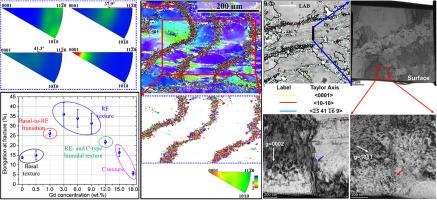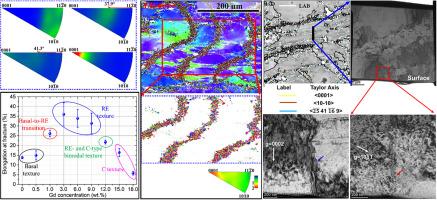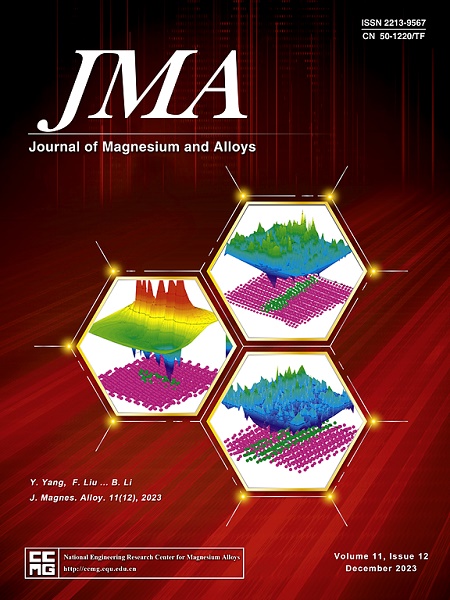挤压 Mg-RE 合金非基质纹理的起源及其对纹理工程的影响
IF 13.8
1区 材料科学
Q1 METALLURGY & METALLURGICAL ENGINEERING
引用次数: 0
摘要
这项工作旨在研究挤压镁合金中非基态纹理的形成和转变机制。为此,以纯镁为参照物,制备了八种镁钆二元合金(钆浓度范围为 0.5 wt.%-18wt.%)进行挤压。研究表明,在稀释的镁钆合金中,纯镁的基底纤维纹理转变为稀土(RE)纹理,而在高浓度镁钆合金中则转变为异常的 C 型纹理。在纯镁中,不连续动态再结晶在挤压过程中起主导作用,从而形成典型的基底纤维纹理。高浓度钆合金阻碍了动态再结晶过程,促进了剪切带的异质成核以及剪切带内的动态再结晶。剪切带内的动态再结晶晶粒的成核取向与寄主变形母晶粒相似,并在生长过程中通过吸收位错使其 c 轴逐渐向挤压方向倾斜,从而形成 RE 纹理取向或 C 纹理取向,具体取决于剪切带内的存储能量。通过 IGMA 和 TEM 表征分析发现,剪切带源于金字塔 I 滑移的广泛但异质的激活。拉伸试验表明,断裂伸长率与纹理类型密切相关。全面了解镁合金中不同纹理成分的形成和转变机制,对于通过纹理工程设计高性能镁合金具有重要意义。本文章由计算机程序翻译,如有差异,请以英文原文为准。


On the origin of non-basal texture in extruded Mg-RE alloys and its implication for texture engineering
The work aims to investigate the formation and transformation mechanism of non-basal texture in the extruded Mg alloys. With this purpose a pure Mg as reference and eight Mg-Gd binary alloys with the Gd concentration ranging from 0.5 wt.% to 18 wt.% were prepared for extrusion. This study shows that the basal fiber texture in pure Mg transited into RE (rare earth) texture in diluted Mg-Gd alloys and into the abnormal C-texture in high-concentration Mg-Gd alloys. In pure Mg, discontinuous dynamic recrystallization plays a predominant role during the extrusion process, resulting in the formation of a typical basal fiber texture. Alloying with high concentration of Gd impedes the dynamic recrystallization process, facilitating the heterogeneous nucleation of shear bands as well as the dynamic recrystallization within shear bands. Dynamic recrystallized grains within shear bands nucleate with a similar orientation to the host deformed parent grains and gradually tilt their c-axis to the extrusion direction during growth by absorbing dislocations, leading to the formation of either the RE-texture orientation or the C-texture orientation, depending on the stored energy within shear bands. The analysis aided by IGMA and TEM characterization reveals that the shear bands originate from the extensive but heterogeneous activation of pyramidal I slip. Tensile tests illustrate a close correlation between the fracture elongation and texture types. A comprehensive understanding of the formation and transformation mechanism of different texture components in Mg alloys holds significant importance for the design of high-performance Mg alloys by texture engineering.
求助全文
通过发布文献求助,成功后即可免费获取论文全文。
去求助
来源期刊

Journal of Magnesium and Alloys
Engineering-Mechanics of Materials
CiteScore
20.20
自引率
14.80%
发文量
52
审稿时长
59 days
期刊介绍:
The Journal of Magnesium and Alloys serves as a global platform for both theoretical and experimental studies in magnesium science and engineering. It welcomes submissions investigating various scientific and engineering factors impacting the metallurgy, processing, microstructure, properties, and applications of magnesium and alloys. The journal covers all aspects of magnesium and alloy research, including raw materials, alloy casting, extrusion and deformation, corrosion and surface treatment, joining and machining, simulation and modeling, microstructure evolution and mechanical properties, new alloy development, magnesium-based composites, bio-materials and energy materials, applications, and recycling.
 求助内容:
求助内容: 应助结果提醒方式:
应助结果提醒方式:


